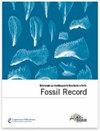Torsten M. Scheyer
下载PDF
{"title":"长颈龟和短颈龟(鳖亚纲,鳖亚纲)壳中保存的骨微观结构","authors":"Torsten M. Scheyer","doi":"10.1002/mmng.200800009","DOIUrl":null,"url":null,"abstract":"<p>Extant and fossil chelids are restricted to South America and Australasia. Based on morphological data, long-necked and short-necked chelids are hypothesised to form natural groups respectively, whereas molecular and serological data indicate South American and Australasian chelids are monophyletic, regardless of neck-length. Here I provide shell bone histological and microanatomical data and character mapping of seven chelid taxa and the Late Jurassic stem-pleurodiran <i>Platychelys oberndorferi</i> Wagner, 1853 to test both competing hypotheses. The chelid shells show conserved bone microstructures, many of which are plesiomorphic for all turtles. Part of the variation among chelid shell microstructures could be attributed to functional aspects associated with the ecology of the taxa, i.e. adaptation to an aquatic lifestyle. The character mapping further indicates that the hypothesis of clades based on neck length is supported by two synapomorphies (i.e., parallel-fibred bone grading into lamellar bone in internal cortex and vascularisation of internal cortex) and one less tree step (16 instead of 17) in contrast to the molecular-based separation based on geographic distribution. (© 2009 WILEY-VCH Verlag GmbH & Co. KGaA, Weinheim)</p>","PeriodicalId":55147,"journal":{"name":"Fossil Record","volume":"12 1","pages":"47-57"},"PeriodicalIF":2.1000,"publicationDate":"2009-02-20","publicationTypes":"Journal Article","fieldsOfStudy":null,"isOpenAccess":false,"openAccessPdf":"https://sci-hub-pdf.com/10.1002/mmng.200800009","citationCount":"20","resultStr":"{\"title\":\"Conserved bone microstructure in the shells of long-necked and short-necked chelid turtles (Testudinata, Pleurodira)\",\"authors\":\"Torsten M. Scheyer\",\"doi\":\"10.1002/mmng.200800009\",\"DOIUrl\":null,\"url\":null,\"abstract\":\"<p>Extant and fossil chelids are restricted to South America and Australasia. Based on morphological data, long-necked and short-necked chelids are hypothesised to form natural groups respectively, whereas molecular and serological data indicate South American and Australasian chelids are monophyletic, regardless of neck-length. Here I provide shell bone histological and microanatomical data and character mapping of seven chelid taxa and the Late Jurassic stem-pleurodiran <i>Platychelys oberndorferi</i> Wagner, 1853 to test both competing hypotheses. The chelid shells show conserved bone microstructures, many of which are plesiomorphic for all turtles. Part of the variation among chelid shell microstructures could be attributed to functional aspects associated with the ecology of the taxa, i.e. adaptation to an aquatic lifestyle. The character mapping further indicates that the hypothesis of clades based on neck length is supported by two synapomorphies (i.e., parallel-fibred bone grading into lamellar bone in internal cortex and vascularisation of internal cortex) and one less tree step (16 instead of 17) in contrast to the molecular-based separation based on geographic distribution. (© 2009 WILEY-VCH Verlag GmbH & Co. KGaA, Weinheim)</p>\",\"PeriodicalId\":55147,\"journal\":{\"name\":\"Fossil Record\",\"volume\":\"12 1\",\"pages\":\"47-57\"},\"PeriodicalIF\":2.1000,\"publicationDate\":\"2009-02-20\",\"publicationTypes\":\"Journal Article\",\"fieldsOfStudy\":null,\"isOpenAccess\":false,\"openAccessPdf\":\"https://sci-hub-pdf.com/10.1002/mmng.200800009\",\"citationCount\":\"20\",\"resultStr\":null,\"platform\":\"Semanticscholar\",\"paperid\":null,\"PeriodicalName\":\"Fossil Record\",\"FirstCategoryId\":\"89\",\"ListUrlMain\":\"https://onlinelibrary.wiley.com/doi/10.1002/mmng.200800009\",\"RegionNum\":4,\"RegionCategory\":\"地球科学\",\"ArticlePicture\":[],\"TitleCN\":null,\"AbstractTextCN\":null,\"PMCID\":null,\"EPubDate\":\"\",\"PubModel\":\"\",\"JCR\":\"Q3\",\"JCRName\":\"Earth and Planetary Sciences\",\"Score\":null,\"Total\":0}","platform":"Semanticscholar","paperid":null,"PeriodicalName":"Fossil Record","FirstCategoryId":"89","ListUrlMain":"https://onlinelibrary.wiley.com/doi/10.1002/mmng.200800009","RegionNum":4,"RegionCategory":"地球科学","ArticlePicture":[],"TitleCN":null,"AbstractTextCN":null,"PMCID":null,"EPubDate":"","PubModel":"","JCR":"Q3","JCRName":"Earth and Planetary Sciences","Score":null,"Total":0}
引用次数: 20
引用
批量引用

 求助内容:
求助内容: 应助结果提醒方式:
应助结果提醒方式:


